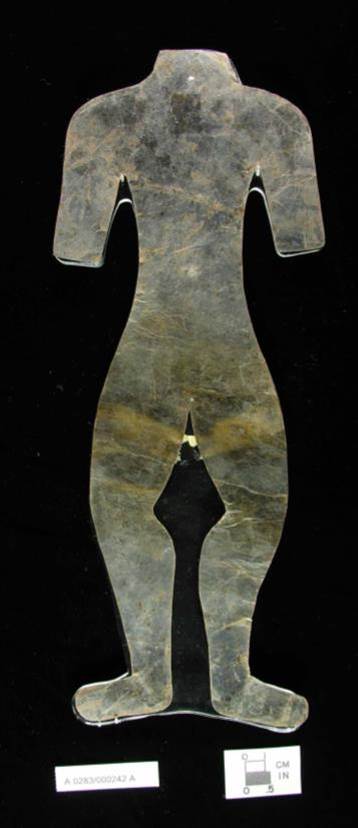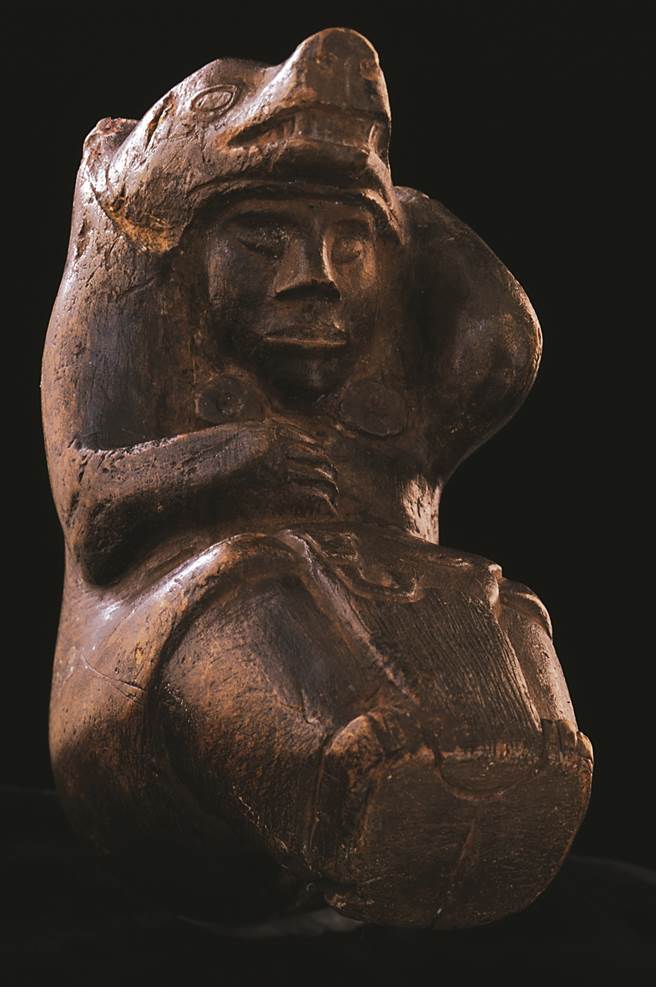The interpretation of so-called “trophy skulls” found in Hopewell mounds has been the subject of considerable debate over the years. Henry Shetrone, in his book The Mound-Builders, described one of these skulls, which was associated with the burial of an elderly male in one of the small mounds of the Hopewell Mound Group. The separate skull was “that of a young male. On it are numerous marks of the flint knife used in carefully removing the scalp and tissues. A helmet-shaped copper headplate and vestiges of a cap or bonnet of woven fabric to which the headplate had been attached surmounted the skull. It may reasonably be surmised that the old man was a war chief and the separate skull that of a vanquished enemy, placed in the grave as a trophy of his prowess; or perhaps it was that of a cherished relative, preserved as a personal or family relic.”

Mica cut-out of a human torso with no head or arms from the Hopewell Mound Group. It could represent a mutilated enemy or an honored ancestor from whom selected body parts have been removed for veneration (A283/242a)
In addition to the skulls, there are various iconic depictions of detached human heads and headless bodies in Hopewell art, but these are subject to the same alternative interpretations. A mica cut-out of a headless human torso might represent a mutilated enemy’s body or a ritually dismembered ancestor. The sculpture of a Hopewell shaman wearing bear regalia and holding a human head could depict an act of ancestor worship or some sort of ritual honoring or debasing a defeated enemy. In my March column in the Columbus Dispatch I discuss the debate in the context of a recent analysis of documented trophy heads from Borneo by anthropologists Mercedes Okumura of the University of Sao Paulo and Yun Ysi Siew of the University of Cambridge, which was published in a recent volume of the International Journal of Osteoarchaeology. What do Dayak trophy heads have to do with the Ohio Hopewell? Historically, not much, but because the specific cultural contexts of the Dayak heads are well documented, they provide a suite of characteristics that are known to be a result of headhunting. If the Hopewell skulls share those same characteristics, then the argument that they, too, are trophies of war is strengthened. If, on the other hand, they lack important characteristics shared by the headhunter skulls, then it suggests they may be something other than trophy skulls. Okumura and Siew determined that about 60% of the headhunter skulls showed signs of violence. The most common evidence consisted of cutmarks. Other signs of violence included chopmarks (15%) and “sharp force traumas” (21%). Okumura and Siew concluded that without the historical information associated with the Borneo skulls it would be difficult to tell whether the heads were war trophies or honored ancestors, but it’s abundantly clear that several of these people died violently. On the other hand, none of the Hopewell skulls show signs of trauma other than cutmarks, which Okumura and Siew acknowledge, could be related to “dismemberment and cleaning of bones” as part of “a mortuary custom.”

The Shaman of Newark is a small stone sculpture of a person wearing bear regalia and holding a detached human head. The person holding the head does not appear to be a warrior, but rather some kind of spiritual leader. (Courtesy of the estate of Edmund Carpenter)
Another way of testing the hypothesis that the Hopewell skulls are war trophies, is to see if there is any other evidence of war among the Hopewell. In fact, evidence of violent trauma, such as crushed skulls, spear points lodged between ribs, or forearms broken in the act of blocking an attack (parry fractures) is virtually absent from documented Hopewell skeletons. Moreover, Hopewell hamlets are not surrounded by protective walls and the extensive interaction network of the Hopewell more or less requires that at least certain people could travel relatively freely across social boundaries. When you consider all the evidence, it seems more likely that the separate skulls found with Hopewell burials belonged to honored ancestors. Perhaps the Hopewell honored certain people upon their deaths by cutting off their heads, which then became objects of veneration in the same way that early Christians preserved relics of saints.

Detail of the detached human head in the lap of the shaman. (Courtesy of the estate of Edmund Carpenter)
As for artifacts such as the mica cut-out and the Shaman of Newark, perhaps they depict episodes from the lives of the Hopewell “saints.” For example, in the Popol Vuh, the “Mayan Bible,” a man named One Hunahpu and his brother are defeated by the lords of Xibalba, the Mayan Underworld. The lords cut off One Hunahpu’s head and place it in the fork of a tree. Sometime later, the head speaks to a young woman and impregnates her with spittle. She gives birth to the hero twins Hunahpu and Xbalanque who return to Xibalba to avenge their father. There is no evidence that the Hopewell shared this particular story with their southern cousins, but it seems likely that they would have used their art to illuminate their own traditional stories, just as the Maya did. Indeed, I think the Shaman of Newark sculpture may have been designed to be held in the hands and manipulated as a sort of animated aid to telling such a story. I demonstrate the idea in a video on the Ancient Ohio Trail website. Regrettably, we are no longer able to hear the words of the stories that enlivened this magnificent figurine for the Hopewell, but it’s becoming increasingly clear that these stories would not have been about mighty warriors lopping the heads off of their defeated enemies.
Brad Lepper
For further reading: Lloyd, Timothy C. 2000 Human remains as burial accompaniments at the Hopewell site. West Virginia Archeologist 52:53-70. Okumura, Mercedes and Yun Ysi Siew 2013 An osteological study of trophy heads unveiling the headhunting practice in Borneo. International Journal of Osteoarchaeology 23:685-697. Seeman, Mark F. 2007 Predatory War and Hopewell trophies. In The taking and displaying of human body parts as trophies by Amerindians, edited by Richard J. Chacon and David H. Dye, pp. 167-189. Springer Science, New York.